Updated Sunday, April 5 03:41 am EST
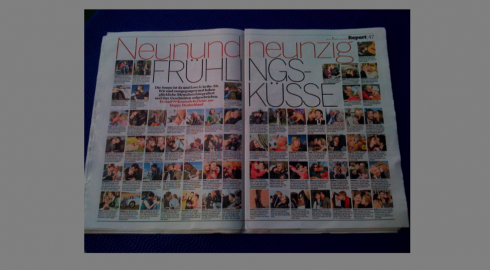
Today’s double-spread feature: 99 spring kisses…..
Bild Zeitung: always a surprise in the package
It is no secret that I am a fervently open admirer of Germany’s Bild Zeitung—-that most colorful of all the down market tabloids (ironically, it is not a tabloid, it is a big, grosse grosse broadsheet). To me, BZ represents the newspaper that does it all with gusto, mucho gusto, if you will.
In fact, this past week in Bucharest, while conducting a series of lectures, a designer in the audience asked a quesion that involved Bild Zeitung. Here was the question, which I paraphrase from memory:
Can you explain to me when bad design serves a purpose, as in the Bild Zeitung, of Germany, as opposed to good design doing its thing, as in Die Zeit, also of Germany?
I think I probably surprised the questioner, and the entire audience, with my response: “Bad design for Bild Zeitung? Are you kidding?,” I responded immediately. “It is one of my favorite newspapers, especially on Sunday. Why? Because, to me, good design is that which is appropriate for the medium and audience for which it is intended. Within that definition, nobody does it better than Bild Zeitung, and consistently, which is important. I call what this colorful exotic bird of a newsapper does “systematic chaos”, with visual continuity and surprises everywhere.
I also wonder if it takes a special talent to design pages like those on the BZ. Is it special skills? Perhaps I would welcome a sort of “internship” at the Bild Zeitung, to get my hands in there and see how I would put five cutout photographs on one page, then appear with a red bubble on one of the corners, or blow a headline to 500 points. It would be fun. Life would never be the same, I am sure. When I open a copy of the Bild Zeitung my eyes suddently find themselves in front of the biggest Sunday brunch in town, but the design and the content stop short of overwhelming you. It is just the right amount of razzmatass or design razzle-dazzle to keep you turning those pages. Isn’t that what it is all about? It is good design for both, the Bild Zeitung and for Die Zeit. Two different styles with design that immediately conveys the mood, tone and flavour of the publication for which they were created.
In today’s edition, the best candy in the box is a story that belongs with the season: 99 best spring kisses.
And the designers do justice to the headline, with 99 small photos of a variety of people kissing each other: from the romantic kiss to the one grandma plants on her grandson’s cheek.
We need more Bild Zeitung surprises.
Bar codes and the multimedia newspaper of the future: a Romanian’s view

Here is a pdf of the “multimedia newspaper” concept.
One of the many journalists who approached me for a little chat in Bucharest was Petre Danoiu, who describes himself as a visual journailst, and who was quite enthusiastic as he showed me what he considers to be a possible model for the newspaper/online combination of the future. Petre calls his creation, “the multimedia newspaper” , and it uses those bar codes we are all used to seeing for a variety of functions from supermarket product pricing to airline boarding passes.
Petre describes the future as “maybe in 2029, or maybe sooner”, and his creation is based on the assumption that people will always appreciate a printed newspaper more than an online or digital edition. or even television, radio, etc..
“Let’s have online reinvent offline,” Petre tells me..
How does he propose to do this? He pulls out a printed copy of his concept newspaper, a dummy, in a very compact A4 format, where one sees bar codes running across the top of the pages.
Petre says he was inspired by Umberto Eco’s writing in a document titled From Internet to Gutenberg.
And here is how Petre explains it:
I named the project “Net 2.0.28 – The multimedia newspaper”. I’m using
the conventional printing technology in order to convert the printed information into the digital world by using the barcodes (Semacode, or
QR Code). Sure, at this moment, when barcodes are used only as “shortcut” to www , the barcodes technology is not allowing us to stock
big amounts of information, but Net 2.0.28 is a newspaper for the year 2028 (design made in 2008). At that time, the printing technology will
allow us, I’m sure, to print unique copies, personalized newspapers,customized ones, for each subscriber.
Customizing editions for individual users is part of Petre’s plan. In fact, the prototype he showed me included several pages for a fictitional user named Julia, in which all the contents would be those that Julia specifically subscribed to receive.
Go here to download pdf of the multimedia newspaper:
http://s4.transfer.ro/storage/transfer_ro-83ae570c90.zip
For those interested in more information, contract Petre directly:
petredanoiu@gmail.com

From IFRA Executive News Service: links of materials that may be of interest, and which relate to topics I have touched upon during the past week:
– Murdoch says papers should charge on Web
http://www.reuters.com/article/marketsNews/idINN0228941620090403?rpc=44
“People reading news for free on the Web, that’s got to change,” said Murdoch speaking at The Cable Show, an annual cable television industry event, in Washington, D.C.
– Cover: Don’t Stop the Presses! Ten experts share their ideas for reinventing the print newspaper
http://www.naa.org/Resources/Publications/PRESSTIME/PRESSTIME-2009-April/01-Cover-Dont-Stop-the-Presses/01-Cover-Dont-Stop-the-Presses.aspx
Try to count the number of times a death knell has sounded for the print newspaper, and you’ll quickly run out of fingers. Despite continued rumors of its impending demise, print still accounts for the overwhelming majority of revenue at most newspaper companies. It also plays an important role for readers.
– UK: FT.com launches new blogs, appoints Bede McCarthy FT.com Executive Editor and Sarah Laitner as Blogs Editor
http://www.ukaop.org.uk/cgi-bin/go.pl/news/article.html?uid=2369
The Financial Times has announced the launch of new blogs on FT.com, including a G20 blog that will cover the events of this week and ongoing dedicated energy, science and health blogs.
– Singapore: ST.com hits record highs
http://www.asiamedia.ucla.edu/article-southeastasia.asp?parentid=106459
THE Straits Times online website broke new records in March, hitting an all-time high in both page views and unique visitors.
– The Future of Advertising: Just Ask “What Would Google Do?”
http://www.micropersuasion.com/2009/04/the-future-of-advertising.html
Media pundit and thinker Jeff Jarvis tackles this question head on with a new book by the same title. In “What Would Google Do?,” Jarvis breaks down Google’s practices into 12 distinct rules and then applies them to aging industries like media and advertising.
I interviewed Jeff by email on Google’s model to get his thoughts.
– Breaking Tweets: a new way to write stories?
http://www.editorsweblog.org/web_20/2009/04/breaking_tweets_a_new_way_to_write_a_sto.php#more
An editor writes a short introduction to a story topic and then tweeters will send in their opinions, eyewitness media, or related links. The 28 editors at Breaking Tweets will then organize the most interesting feeds in an order that makes sense.
– Jacek Utko: Can design save the newspaper?
http://www.ted.com/index.php/talks/jacek_utko_asks_can_design_save_the_newspaper.html
I posted this video, as many others did, last week, prompting a designer colleague to write back immediately with a comment:
“C’mon, Mario, do you really think that the poster page design is going to save the newspaper?”
Said I: Of course not. I constantly remind those within earshot that design alone, regardless of the model executed, cannot save a newspaper that has lost touch wtih its readers, and abandoned its soul.However, I see this blog as a forum to present various opinions and ideas.
A selected bibliography about blogging
Several of you asked me for an updated bibliography about blogs and blogging.
This selection is courtesy of : David Shedden, Poynter Library director:, who, as usual, provided us with most valuable information.
“When Journalists Blog: How It Changes What They Do”
Paul Bradshaw, Nieman Reports, Winter 2008
http://www.nieman.harvard.edu/reportsitem.aspx?id=100696
“Journalism as a Conversation”
Katie King, Nieman Reports, Winter 2008
http://www.nieman.harvard.edu/reportsitem.aspx?id=100670
“Bloggers and Other Online Publishers Face Increasing Legal Threats”
David Ardia, Poynter Online, September 22, 2009
http://www.poynter.org/column.asp?id=101&aid=150968
“Murky Boundaries: What are the Guidelines for the Personal Blogs of Journalists who work for Mainstream News Organizations?”
Kevin Rector, AJR, June/July 2008
http://www.ajr.org/Article.asp?id=4522
“Blogging Journalists: Suvey Results Pt. 1.”
Paul Bradshaw, Online Journalism Blog, October 14, 2008
http://onlinejournalismblog.com/2008/10/14/blogging-journalists-survey-results-pt1-context-and-methodology/
“Blog History 101”
Simon Owens, MediaShift, September 22, 2008
http://www.pbs.org/mediashift/2008/09/scott-rosenberg-traces-the-blogospheres-origins266.html
“Blog History”
Liz Donovan, Behind the News, April 9, 2007
http://newsresearch.blogspot.com/2007/04/blog-history.html
“Blogs Turn 10 – Who’s the Father?”
Declan McCullagh and Anne Broache, CNET News, March 20, 2007
http://news.cnet.com/2100-1025_3-6168681.html
“History of Blogging Timeline”
Wikipedia
http://en.wikipedia.org/wiki/History_of_blogging_timeline
The one-advertiser edition for Gazeta Sporturilor
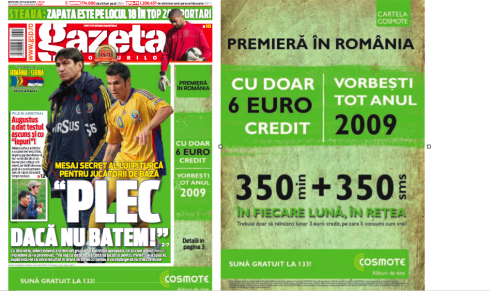

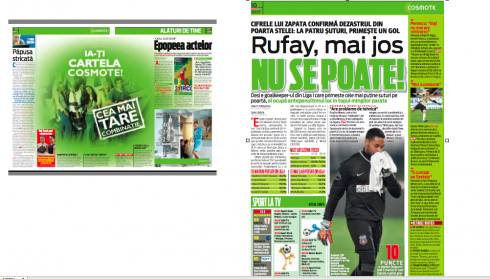
As I reviewed the Romanian newspapers during my visit to Bucharest to speak to editors, publishers and designers in a program sponsored by the Media Management Institute and the US Embassy, one newspaper stood out, Gazeta Sporturilor, especially because it seemed to be the one daily here more willing to experiment with advertising strategies that deviate from the traditional.
I engaged in conversation with its editor, Catalin Tolontan (tolo.ro) who explained that his newspaper attempts to do these “one advertiser” edition several times a year, and that this experiment brings about 15000 euros worth of revenue. For example, the pages shown here were bought entirely one client, Cosmote (a mobile telephone service provider).
The idea is not totally revolutionary, as I have seen similar approaches to one-advertiser editions in Latin America and some parts of Europe. I think that, for a specialized newspaper, such as a sports or business daily, this may be an interesting approach worth considering occasionally. I don’t believe it is feasible, nor very client friendly, to sell the entire newspaper to one advertising client everyday, at the risk of alienating the others. On special occasions, why not?
As Gazeta editor Tolontan put it to me: “This is one way we have of adapting to the financial crisis, and we welcome such experimentation, especially at times like this.”
The following link shows two similar projects with advertising clients BRD – Groupe Societe Generale and Ceresit (Henkel):
http://s4.transfer.ro/storage/transfer_ro-752412ae06.zip
Reviewing the Romanian newspapers
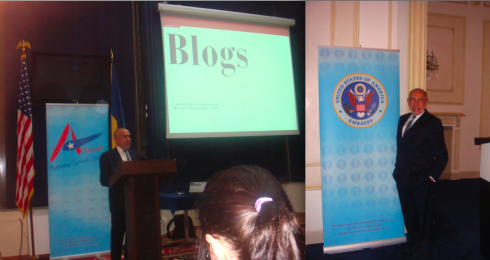
Here I am this evening, speaking at the US Embassy in Bucharest: the topic, all about Blogs
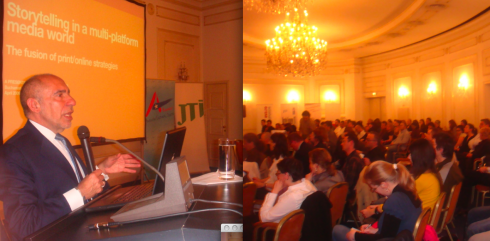
Earlier in the day, speaking to Romanian publishers, editors and designers
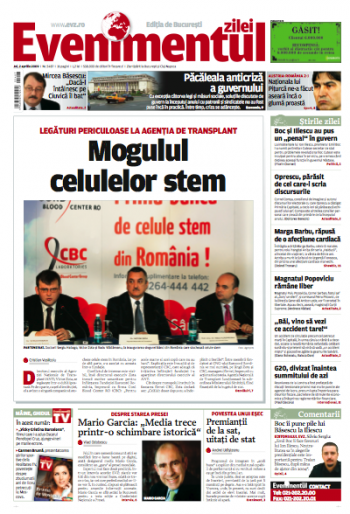

Eveninmentul zilei is a midmarket daily (notice interview with me bottom of page); Business Standard, is a new financial daily in Romania, in tabloid format.
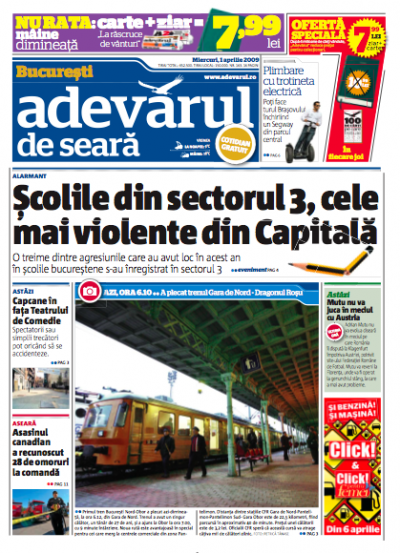
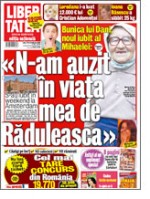
Adevarul is one of the “quality” midmarket newspapers with various regional editions, with powerful promotion/marketing campaigns, such as giving out books; Libertatae is the largest circulation and largest readership of any newspaper in Romania.
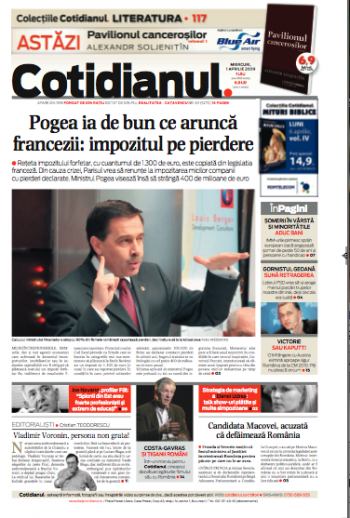

Cotidianul is a quality newspaper in tabloid format; Gazeta Sporturilor is colorful and full of important sports information
From one transition to the next
With about 150 editors, publishers, designers in the audience, all the questions usually turn to “how can we survive?”, with a few trying to learn as much as possible from the “mistakes of the American newspapers”.
However, quick conversations with publishers and editors show that, in many cases, traditional journalism prevails here, and little or no investment is made on the newspaper’s online operations, although I am happy to see that there are already some financial online newspapers that do not exist in print (www.wall-street.ro). LIke U.S. editors 10 years ago, some of the Romanian editors I meet still think that it is NOT news until it appears in print. There is little, if any, experimentation with advertising.
The existing newspapers fall into three main categories: the serious ones who, as one editor puts it, pride themselves in “being heavy” (this means long texts without interruptions, few graphics and a front page that is more 9 point than anything else, in a broadsheet format!). Then there are the contemporary ones: breezy, colorful, dynamic. And, a big basket of the tabloid variety, with the big headlines, the cutout photographs on every page, and one 300 point headline after the other. The largest circulation daily here, Libertatea, falls into this category.
One thing that is of interest to me, in this my first incursion into Romania, is that the design and texture of newspapers here falls into two camps: either they look like Swiss or German dailies, or like Spanish ones. Change the language, and, presto, you could be reading a newspaper from Geneva or Sevilla. Nothing wrong with that, of course, except that as I travel the world I see the loss of some of the “country/cultural” flair that newspapers always had, somehow lost. Because we have Internet access and we can see what others are doing, we are more likely to target our products after successful ones elsewhere. I ask the locals: what are the major influences here? What does a Romanian newspaper look like?
The audience simply smiled.
“Well, we tend to follow American newspapers here a lot,” Amalia Badescu, Managing Director for MMI, tells me, “but we also love those Spanish newspapers, and we have a major Swiss media house, Ringier, involved with ownership of some of the dailies, so those influences show.”
Blogging thrives in Romania
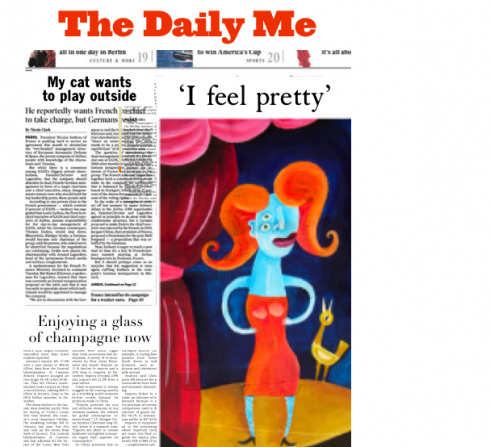
Color illustration by Andrew Skwish (http://www.skwish.com/)
One of my sessions here was specifically devoted to the impact and influence of Blogs, with tips for Romanian bloggers on how to make their blogs more interesting. This session took place at the U.S. Embassy of Romania. A group of about 20 bloggers gathered for the occasion, a large number of whom described themselves as journalists who blog.
Some highlights of my talk:
A new force: Blogs are already changing the way we practice journalism, and shaping the world in which we live. Not to mention their impact on the political landscape. Think Obama campaign blogs
People make the difference: Traditional journalism is practiced by journalists, blogs open the door for the masses to participate. The audience is part of the process. My actual quote was:
When you practice traditional journalism, it is as if you play tennis against the wall. With blogging, there is always the instant comeback from the audience. It is like playing tennis with Serena Williams, and she throws the ball back at you. More exciting and a more complete process of interaction.
Tips for making those blogs more visually appealing: Use visuals to draw your readers in; write crisp, short headlines to identify each topic; use bold face to highlight names; use color to create a branding/identity for your blog.
The topics: Emphasize variety, from newsy to featury to the very light and personal. Blogs are opinionated, so let your ideas be known, and express them with force and conviction.
Objectivity, the landmark of traditional journalism, is not what it is about here. However, accuracy always is!
The Daily Me concept: It is no secret that blogs are part of this The Daily Me concept where we all express how we feel, what we believe, what we like and don’t like. In that sense, your blog is a daily front page of your feelings and ideas for a given day. I know mine is. It is not everyday that you have something extremely interesting, let alone profound, to say. But your readers flock to you because, regardless of the subject, there is always the element of surprise, and, often, valuable information to share as well.
Roy Peter Clark and blogs
Dr. Roy Peter Clark, long-time friend and one of my dearest colleagues at The Poynter Institute for Media Studies, where he has been the reigning writing guru for more than 25 years, was extremely helpful as I prepared my blog presentation. Roy always offers unique and insightful views on the craft of writing, and here are highlights of his remarks to me as I asked him for his contributions with the blogs and blogging presentation. Many thanks, Roy!
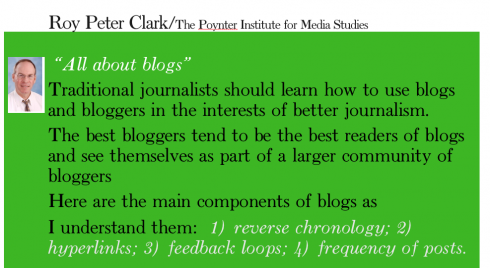
My special thanks also go to David Shedden, Poynter Library director, for his valuable assistance with an updated bibliography on blogging, which helped me tremendously.
Recommended books about blogging

Jim McManus send us a great tip about two books related to blogging, by Biz Stone, that I definitely plan to read soon, while the subject of blogging is right up there to the front of my head.
Here is how Jim introduces the books to me in an email:
About 6 years ago I used to have these long discussion about blogging with a young friend named Biz Stone who was an early blogging enthusiast and wrote a couple of books on the subject. I used to tell him that this whole blogging thing was overrated and would never take off. I mean who would want to read the aimless musings of some everyman? But he held steadfast and ignored my ill-informed thoughts on the subject. He later joined Google and Blogger and later still became one of the three founders of Twitter.
The books are by Biz Stone:
Blogging: Genius Strategies for Instant Web Content
Who Lets the Blogs Out?
Biz’s books can be found here:
http://www.amazon.com/exec/obidos/search-handle-url/ref=ntt_athr_dp_sr_1?%5Fencoding=UTF8&search-type=ss&index=books&field-author=Biz%20Stone
A flash from the communist past
When the curtain came down on communism here in Romania——which historians officially cite as Dec. 22, 1989, the end of Nicolae Ceaucescu’s dictatorship, after 42 years of Communist rule which also included leaders Gheorghe Gheorghiu-Dej and Nicolae Ceaucescu——it also opened doors and windows to the press, which could finally be free, as opposed to propaganda machines.
One editor was telling me today that during communism, newspapers were full of propaganda, but the VALUE ADDED was in two areas: classified ads and obituaries.
“Yes, people ignored all the propaganda the government dispensed page after page, but they got the newspaper to deal with sales, a little capitalism in the middle of the rest. We could sell a piano, a lamp, or buy something. And, of course, we wanted to know who had died, to perhaps attend the funeral services and go to the burial. That was the true value of a newspaper in those days.”
:
To read TheRodrigoFino blog, in Spanish, go:
https://garciamedia.com/latinamerica/blog/
TheMarioBlog posting #232